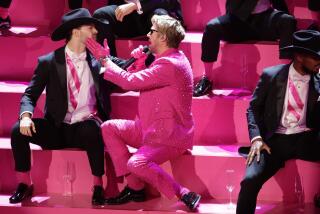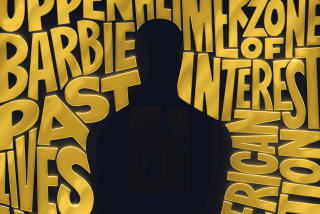The Envelope: Hans Zimmer’s ‘Interstellar’ music and other scores vie for Oscar
At its best, film can take viewers to new worlds or reveal truths about ones they thought they knew. This year, composers from all over this world have undertaken those journeys with Oscar-contending scores, from a trip to far-flung reaches of space with earthbound instruments to the unexpected innovation of a grueling trek across the American frontier.
Hans Zimmer
‘Interstellar’
There’s a reason Oscar winner and nine-time nominee Hans Zimmer’s “Interstellar” score is so present in Christopher Nolan’s movie: It’s part of the film’s DNA.
“The music and the movie are being made simultaneously. It’s not an afterthought; it’s an integral part of his process,” says the German-born Zimmer. Having worked closely with Nolan for a decade, the two collaborate in the earliest stages.
“Long before he started shooting,” Zimmer says, “we had a main theme, we had figured out what we wanted our language to be — for instance, four pianos, the idea of the big church organ was very important to us, and far more emphasis on the woodwinds.”
Zimmer confirms the oft-reported tale that Nolan came to him with a single page of script and asked him to compose for a day based on its father-daughter dynamic. After hearing the result, Zimmer says Nolan told him, “I guess I’d better make the picture now!” That simple, intimate theme stayed with the project to the end, becoming embedded throughout the score.
The music can swell to expressions of tremendous power, sure — that pipe organ’s crescendos! — but it also sprinkles moments of loving fragility amid its cosmic beauty.
“Chris very casually mentions ideas: ‘Wouldn’t it be nice to figure out a way of consolidating the ideas of relativity, time and quantum mechanics?’ So I go off — I don’t actually have to do it; I just have to make you feel as if it’s happening,” he says, laughing.
“That’s the cool thing about music; you can be poetic about science.”
Jóhann Jóhannsson
‘The Theory of Everything’
The Icelandic composer didn’t get to meet Stephen Hawking when scoring the film about the youthful romance between the renowned physicist and his eventual wife, Jane Wilde.
By email, Jóhannsson says he reread “‘A Brief History of Time’ to get a sense of his voice as a writer before I started writing the music. I think his sense of humor and the poetic, almost lyrical, way he writes about physics was very inspiring.
“His relationship with Jane is really the heart of the film. This was represented by the piano, which is a very expressive and precise instrument. It has this mathematical and mechanical kind of quality to it which unites the emotions and human aspects with the cerebral, scientific parts.”
Gustavo Santaolalla
‘The Book of Life’
The two-time Oscar winner from Argentina, who composed both the songs and the score, says, “Usually, my scores have been known for being very spare, very minimalistic use of instrumentation. This demanded a big orchestra, a lot of music — usually these films are wall-to-wall music. But I’m an advocate of the concept of identity.
“So I made sure I could play around with Latin American rhythms and instruments — Mexican in this case — that would evoke that culture. That was the big test, to keep it in the code of what these types of films call for, but at the same time to do something that was different, unique in its own sense.”
Marco Beltrami
‘The Homesman’
Director, co-writer and costar Tommy Lee Jones wanted the film’s score “to have the spirit of a classic western — the instrumentation, some of the flavors of traditional western music, was something he thought would be interesting in the beginning,” says two-time Oscar nominee Beltrami. “After that, he was really interested in the spirit of innovation and creativity.”
Inspired by the wind-swept panoramas of the characters’ journey across the frontier, Beltrami and collaborator Buck Sanders searched for ways to convey those environs and their emotional effect on the travelers.
“I was inspired by Mary Bee’s character,” says Beltrami of the protagonist played by Hilary Swank. “She had a very idealistic vision of what the West and settling the plain meant. So Mary Bee’s theme, naturally, would be very idealistic. It contrasted with the harsh conditions that surrounded them and drove the women crazy. That was all represented by the wind. So figuring out a way to make that integral to the score was, for me, key to its identity.”
They recorded much of the chamber-string music outdoors on a high hillside. But their search for the right sounds led them even further. They took the concept of the Aeolian harp — which sounds when the wind touches its strings — and applied it to an upright piano up on the hill, running eight of its wires 175 feet to a massive metal storage tank. The sounds it creates have both melodic immediacy and the hollowness of memory.
“The whole thing is so austere — it starts with heaven and Earth and a single line between.” says Beltrami.
More to Read
The biggest entertainment stories
Get our big stories about Hollywood, film, television, music, arts, culture and more right in your inbox as soon as they publish.
You may occasionally receive promotional content from the Los Angeles Times.










